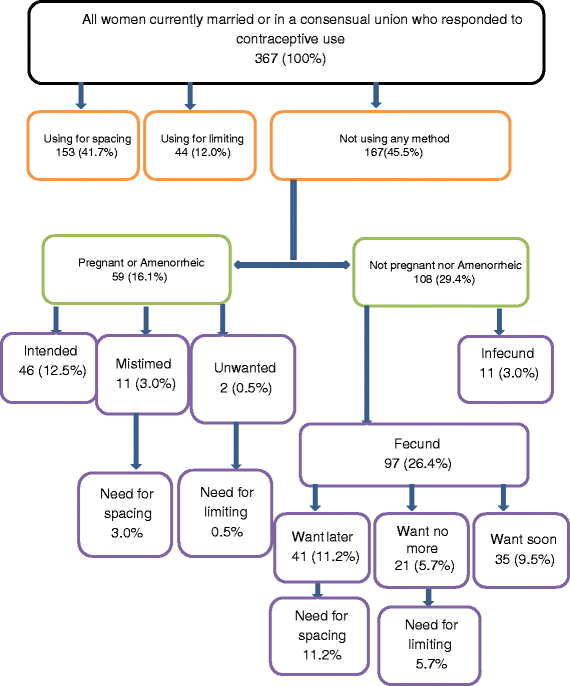Determinants of unmet need for family planning among women in Urban Cameroon: a cross sectional survey in the Biyem-Assi Health District, Yaoundé
- PMID: 26791410
- PMCID: PMC4721192
- DOI: 10.1186/s12905-016-0283-9
Determinants of unmet need for family planning among women in Urban Cameroon: a cross sectional survey in the Biyem-Assi Health District, Yaoundé
Abstract
Background: With the unacceptably high level of unmet need for family planning in Sub-Saharan Africa, reducing unmet need is paramount in the fight against the high levels of induced abortions, maternal and neonatal morbi-mortality. A clear understanding of the determinants of unmet need for family planning is indispensable in this light. The objective of this study was to determine the prevalence of unmet need for family planning in Urban Cameroon while identifying major determinants of unmet need among women in a union in Urban Cameroon.
Methods: A community based cross sectional study was conducted from March 2015 to April 2015 during which 370 women in a union were recruited using cluster multistep sampling in the Biyem-Assi Health District, Yaounde. Data were collected using a pretested and validated questionnaire. Proportions and their 95% confidence intervals were calculated with the Westoff/DHS method used to estimate unmet need for family planning and the odds ratio used as measure of association with statistical significant threshold set at p-value ≤ 0.05.
Results: Of the 370 eligible women included, the mean age was 29.9 ± 6.8 years, and 61.1% were married. The prevalence of unmet need for family planning was 20.4 (16.4-24.8)% with 14.2 (11.2-18.7)% having an unmet need for spacing and 6.2 (3.6-8.7)% an unmet need for limiting. Husband's approval of contraception had a statistically significant protective association with unmet need (AOR = 0.52 [0.30-0.92], p = 0.023), and discussion about family planning within the couple had a highly statistically significant protective association with unmet need (AOR = 0.39 [0.21-0.69], p = 0.001). The major reason for non-use of contraception among women with unmet need was the fear of side effects.
Conclusion: The prevalence of unmet need of family planning among women in the Biyem-Assi Health District remains high. Husband's approval of contraception and couples' discussion about family planning are two major factors to be considered when planning interventions to reduce unmet need for family planning. Family planning activities focused on couples or including men could be useful in reducing the rate of unmet need in Cameroon.
References
-
- Yossa T. Report on the sustainable development goals Central Africa Sub region. Africa Regional Consultative Meeting on the Sustainable Development Goals: Experts Meeting; 31 October - 2 November 2013. Addis Ababa, Ethiopia: Ethiopia; 2013. http://www.uneca.org/sites/default/files/uploaded-documents/SDG/2013/sdg.... Accessed 19 Nov 2014.
-
- Nkosazana CDZ, Carlos L, Kaberuka D, Helen C. MDG Report 2014: Assessing Progress in Africa toward the Millennium Development Goals. Addis Ababa, Ethiopia: Economic Commission for Africa; 2014.
-
- Institut National de la Statistique (INS) et ORC Macro . Enquête Démographique et de Santé du Cameroun 2011. Calverton, Maryland, USA: INS et ORC Macro; 2011.
-
- WHO. Trends in maternal mortality: 1990 to 2013: Estimates by WHO, UNICEF, UNFPA, The World Bank and the United Nations Population Division; 2014. http://apps.who.int/iris/bitstream/10665/112682/2/9789241507226_eng.pdf. Accessed 19 Nov 2014.
Publication types
MeSH terms
LinkOut - more resources
Full Text Sources
Other Literature Sources
Medical
Miscellaneous


